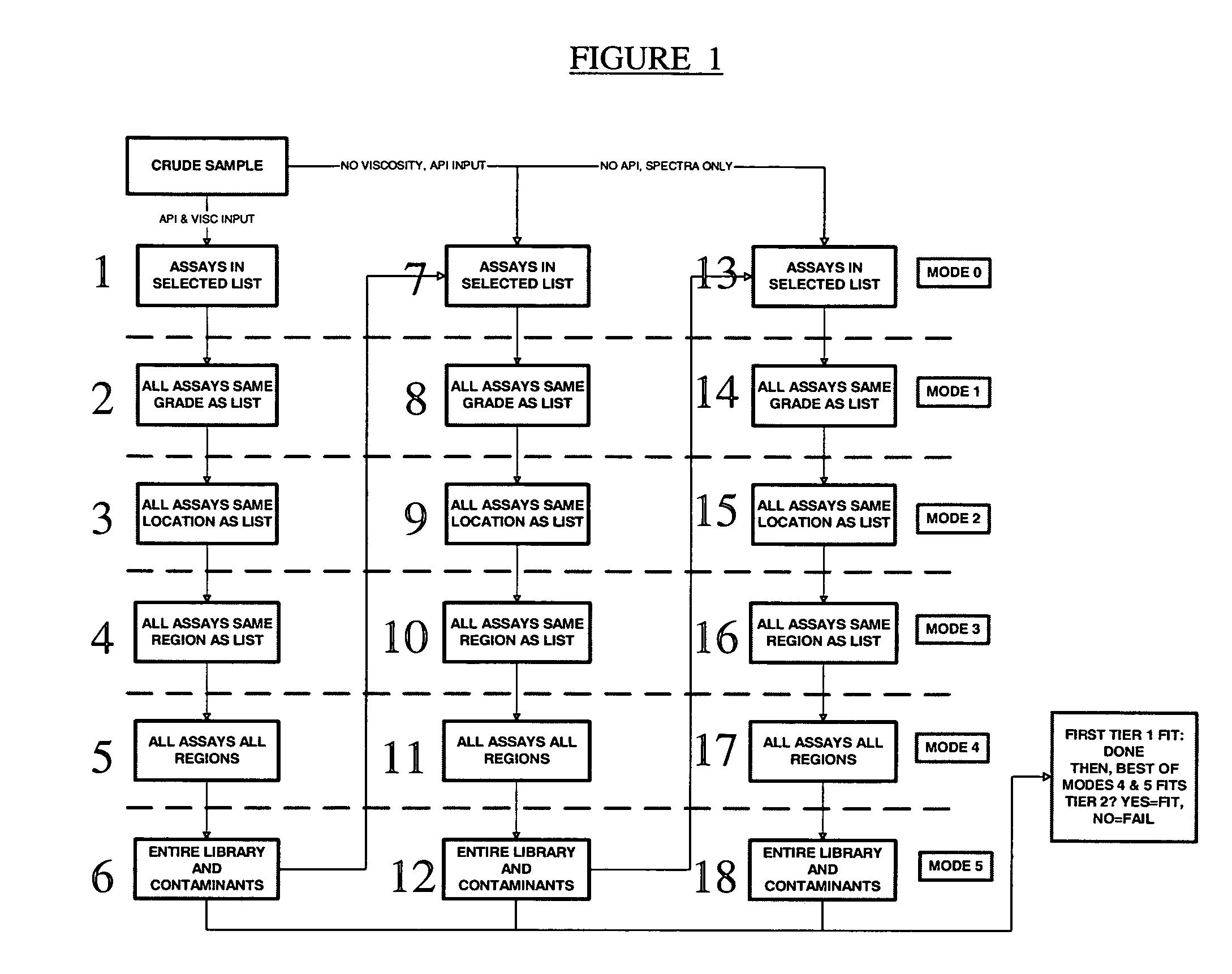Refinery crude unit performance monitoring using advanced analytic techniques for raw material quality prediction
a crude unit and raw material technology, applied in the direction of instruments, hydrocarbon distillation control/regulation, separation processes, etc., can solve the problem of impracticality of routinely measuring cargoes with a laboratory assay, and achieve the effect of overcoming uncertainty, determining crude quality accurately and quickly, and making cheap and easy
- Summary
- Abstract
- Description
- Claims
- Application Information
AI Technical Summary
Problems solved by technology
Method used
Image
Examples
example 1
[0032] Example 1 demonstrates how a Virtual Assay Library is generated and optimized for use in Pipestill Health Monitoring. More details on the calculation and optimization methodology is given in Appendix 1.
[0033] A Virtual Assay library is generated using FT-MIR spectra for 504 crude oils using the methodology described in U.S. Pat. No. 6,662,116 and in Appendex 1. Spectral data in the 4685.2-3450.0, 2238.0-1549.5 and 1340.3-1045.2 cm−1 regions are used. Lengendre polynomials are used in each region to correct for baseline variation. Fifth order (quartic) polynomials are used in the higher frequency region, and fourth order (cubic) polynomials in the other two regions. Corrections are also generated for water vapor, and liquid water dispersed in the crude oil. The difference spectra used to generate the spectrum of liquid water are smoothed to reduce their noise level prior to generating the correction vectors. A total of 17 orthogonal correction vectors are generated including ...
example 2
[0039] In this example, two cargoes of same grade crude exhibit significant differences in API versus the most recent laboratory assay (differences of >0.5 numbers are considered to be outside laboratory reproducibility and therefore significant). The yield pattern was determined by Virtual Assay. In both cases the Virtual Assay was a Tier-1 fit and therefore statistically equivalent to a laboratory distillation. [0040] Cargo 1 has increased by 0.9 numbers [0041] Cargo 2 has increased by 1.4 numbers
[0042] The yields for the major boiling range cuts are shown below. Yield differences of >1.5% are considered to be outside laboratory reproducibility and therefore significant.
Crude 1MeasuredYIELDSYIELDSYIELDSYIELDSYIELDSYIELDSCRUDELight EndsNaphthaKeroAGOVGOResidAPI GravityVPCTVPCTVPCTVPCTVPCTVPCTLaboratory / Assay28.90.9021.1514.1816.1927.4020.18Cargo 129.81.1824.3414.0214.6425.3920.43Cargo 230.31.2825.1614.2914.9024.9419.44Delta 1−0.9−0.3−3.20.21.62.0−0.2Delta 2−1.4−0.4−4.0−0.11.32.5...
example 3
[0044] In this example, three cargoes of another crude were analyzed, each having a 0.6 API offset (statistically significant) versus the laboratory assay. A Virtual Assay was performed on each of the samples. As can be seen from the data, although the API has changed, the internal yield of the crude has not been altered in a statistically significant way. Without Virtual Assay, refinery personnel may have concluded that any actual yield deviation versus that predicted from the laboratory assay data was due to a change in the crude. Using Virtual Assay shows that this would likely be a false assumption.
Crude 2MeasuredCRUDEYIELDSYIELDSYIELDSYIELDSYIELDSAPINaphthaKeroAGOVGOResidGravityVolume %Volume %Volume %Volume %Volume %Difference Virtual Assay (VA) measured in Refinery 1 (R1) orRefinery 2 (R2) versus laboratory assayCargo 1R10.600.520.540.35−0.60−0.79Cargo 2R20.600.400.08−0.150.05−0.44Cargo 3R10.600.99−0.04−0.39−0.47−0.39
PUM
| Property | Measurement | Unit |
|---|---|---|
| Boiling Point | aaaaa | aaaaa |
| temperatures | aaaaa | aaaaa |
| boiling range fractions | aaaaa | aaaaa |
Abstract
Description
Claims
Application Information
 Login to View More
Login to View More - R&D
- Intellectual Property
- Life Sciences
- Materials
- Tech Scout
- Unparalleled Data Quality
- Higher Quality Content
- 60% Fewer Hallucinations
Browse by: Latest US Patents, China's latest patents, Technical Efficacy Thesaurus, Application Domain, Technology Topic, Popular Technical Reports.
© 2025 PatSnap. All rights reserved.Legal|Privacy policy|Modern Slavery Act Transparency Statement|Sitemap|About US| Contact US: help@patsnap.com



